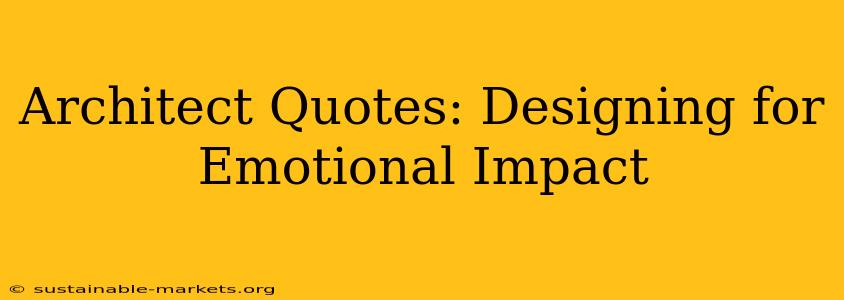Architecture is more than just bricks and mortar; it's about crafting spaces that evoke feelings, tell stories, and resonate with the human spirit. Great architects understand this deeply, imbuing their designs with emotional depth that transcends mere functionality. This exploration delves into the power of architect quotes in revealing this crucial aspect of the design process, showcasing how leading figures in the field articulate their vision for emotionally impactful architecture.
What Makes Architecture Emotionally Impactful?
Before diving into specific quotes, let's establish the key elements that contribute to emotionally impactful architecture. It's not simply about aesthetics, although beauty undoubtedly plays a role. Emotional impact arises from a confluence of factors, including:
- Sense of Place: The ability to create a strong sense of belonging and connection to a specific location. This often involves incorporating local materials, referencing historical context, and acknowledging the surrounding environment.
- Light and Shadow: The skillful manipulation of natural and artificial light can dramatically alter the mood and feeling of a space. Think of the dramatic shadows in a Gothic cathedral versus the bright, airy feel of a modern minimalist home.
- Scale and Proportion: The relationship between the size of the building and the human form, as well as the proportions of different elements within the structure, significantly impact the emotional response. Overwhelming scale can induce awe, while intimate proportions can foster a sense of comfort and security.
- Materiality: The choice of materials – wood, stone, steel, glass – profoundly influences the emotional character of a building. Warm, natural materials often evoke feelings of comfort and connection to nature, while cold, industrial materials can convey a sense of strength and modernity.
- Spatial Experience: The way a building unfolds and guides the user through different spaces shapes the overall experience. A carefully planned sequence of spaces can build anticipation, create moments of surprise, and ultimately leave a lasting emotional impression.
Famous Architect Quotes on Emotional Design
Many renowned architects have articulated their philosophy on the importance of emotional impact in their designs. Their words offer valuable insight into the creative process and the underlying principles of emotionally resonant architecture.
"Form follows feeling." - Frank Lloyd Wright (While not a direct quote, it captures Wright's essence)
While Wright's famous maxim is "Form follows function," his work demonstrably prioritized feeling and emotional experience. His organic architecture aimed to create harmony between the building and its environment, fostering a deep connection between the inhabitant and the surrounding landscape. The feeling of openness, connection to nature, and integration with the environment were paramount in his designs.
"Architecture is the learned game, correct and magnificent, of forms assembled in the light." - Le Corbusier
Le Corbusier's quote highlights the importance of light in creating a powerful emotional response. The interplay of light and shadow, as previously discussed, is crucial in setting the mood and atmosphere of a space. His buildings often employed large windows and strategically placed openings to maximize natural light and create a dynamic spatial experience.
"Architecture should speak of its time and place, but yearn for timelessness." - Frank Gehry
Gehry's philosophy points to the dual nature of successful architecture. It must be relevant to its context, reflecting the cultural and historical influences of its location, but it must also transcend its immediate surroundings, aiming for a universal appeal that resonates across time. This timeless quality is often achieved through the use of powerful emotional cues and universally understood symbolic language.
"A house is a machine for living in." - Le Corbusier
This seemingly functional statement by Le Corbusier, while often cited for its modernist practicality, also underscores his intention to optimize the experience of living. The machine-like efficiency he championed was not devoid of emotion; instead, it was meant to streamline daily life and enhance the enjoyment of inhabiting a space.
How Architects Achieve Emotional Impact in Their Designs
Achieving emotional impact isn't accidental; it's a carefully considered process that involves a deep understanding of human psychology and a masterful application of design principles. Architects employ a range of techniques to evoke specific feelings:
- Biophilic Design: Incorporating natural elements into the built environment to create a sense of calm and connection to nature.
- Material Selection: Carefully choosing materials to evoke particular emotions – the warmth of wood, the coolness of stone, the sleekness of steel.
- Spatial Sequencing: Creating a journey through the space, leading users through a carefully choreographed sequence of experiences.
- Light and Shadow Play: Utilizing light and shadow to highlight key architectural features and set the mood.
Conclusion
Architect quotes serve as a window into the minds of these creative visionaries, revealing their deep understanding of the power of architecture to impact our emotions. By embracing these principles – the thoughtful use of light, material, space, and scale – architects can create buildings that are not merely functional but also deeply moving and resonant experiences. The pursuit of emotional impact isn't merely an aesthetic flourish; it’s the essence of truly great architecture.

